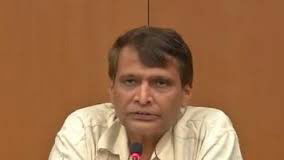Headlines
Passengers spared, freight rates hiked in India's rail budget

Sparing a passenger fare hike but raising freight rates again, Minister
Suresh Prabhu presented his maiden budget for Indian Railways Thursday,
with a slew of measures to improve service quality, safety and reach
and a 52-percent jump in plan outlay for 2015-16 at Rs.100,011 crore
($16.7 billion).
Raising some passenger train speeds by 50
percent on nine key routes, faster freight trains, user-friendly ladders
to mount upper berths, wi-fi in 400 stations, more money for
escalators, easier norms for unreserved tickets, 17,000 bio-toilets in
trains, better connectivity in north-east and cameras for safety of
women travellers are among the other highlights of the budget.
"There
will be no hike in passenger fares. We will focus on improving
passenger amenities, including cleanliness," Railway Minister Prabhu
said in a 66-minute speech in the Lok Sabha, watched keenly by Prime
Minister Narendra Modi who had handpicked him for the job.
Even
though Prabhu made no mention of any revision in freight tariff in his
speech, as has been the norm in the past, the minister, nevertheless,
revised it upward between 2.1 percent and 10 percent, not sparing even
commodities like grain, pulses, urea and coal.
In the previous
budget tabled by the Modi government in July last year, passenger fares
had been hiked by nearly 15 percent while the freight tariff was
increased by 6.5 percent.
The minister also promised a vastly
improved operating ratio, which spells out how much money is spent on
day-to-day operations to earn revenues -- an indication of the funds
left for safety and expansion.
He targeted to bring it down to
88.5 percent, or the lowest in nine years, from an unsustainable level
of 93.6 percent in 2013-14 and 91.8 percent for this fiscal. This is
better than what the prime minister had asked the railways to do a few
days ago.
Globally, a 75-80 percent or lower is seen as a healthy benchmark.
Prabhu
also seemed to have ruled out the sale or leasing of surplus land and
other assets to get revenues. "We will monetize our resources rather
than sell," he said, adding: "Business as usual of asking for budgetary
support from finance ministry is neither sustainable nor necessary."
He
pegged a 52 percent jump in the plan outlay for 2015-16 at Rs.100,011
crore, projecting a 16.7 percent growth in passenger earnings and 13.5
percent in freight. The minister has also proposed a 46.5-percent
increase in market borrowings to bridge the fiscal gap.
Soon
after the budget presentation, Prime Minister Modi gave a thumbs up to
Prabhu. "Rail budget 2015 is forward looking, futuristic and
passenger-centric, combining a clear vision and definite plan to achieve
it,†Modi said in a tweet, even calling it a watershed moment for
railways.
The same, however, was not true with the markets, with
the sensitive index (Sensex) of the Bombay Stock Exchange falling some
260 points, or nearly 1 percent, with most stocks of companies
associated with railways ending in the red.
The minister began his speech with what ails Indian Railways.
"Railway
facilities have not improved very substantially over the past few
decades. A fundamental reason for this is the chronic under-investment
in Railways, which has led to congestion and over-utilization," he said.
"As
a consequence, capacity augmentation suffers, safety is challenged and
the quality of service delivery declines, leading to poor morale,
reduced efficiency, sub-optimal freight and passenger traffic and fewer
financial resources. This again feeds the vicious cycle of
under-investment," he said.
"This must be put to an end," said
the chartered accountant-turned-politician, while presenting the budget
for one of the largest railway network in the world. "We have to make
our Indian Railways a benchmark organisation in safety, security and
infrastructure," he said in a speech peppered with several Hindi
couplets.
Playing with words, he also invoked God (Prabhu) and
said: "One of the first things I asked, 'hey prabhu' how will all this
be possible." Then, amid laughter, he went on to add that while 'prabhu'
as in god did not reply, he took it upon himself, the mortal 'prabhu',
for overseeing the re-birth of Indian Railways.
Earlier the
minister presented a white paper on Indian Railways, which he said will
form a trilogy of what plans he had in mind for one of the largest such
networks in the world along with his budget for 2015-16 and a Vision
2030 document to be presented later in the year.
He also set four
goals to transform Indian Railways: Improved customer experience, safer
travel, modern infrastructure and financial self-sustainability. "We
will also create a separate department for taking care of cleanliness."
For
the record, India boasts one of the oldest and the largest railroad
networks in the world, ferrying some 23 million people, or a population
the size of Australia, as also 2.65 million tonnes of goods on its
coaches, each day.
It serves from 7,172 stations via 12,617
passenger and 7,421 freight trains on a track network spanning Baramulla
in the Himalayan foothills of Kashmir to the southern tip of
Kanyakumari in Tamil Nadu, and from Naharlagun in Arunachal Pradesh to
the port town of Okha in Gujarat.
(Arvind Padmanabhan can be contacted at arvind.p@ians.in)































